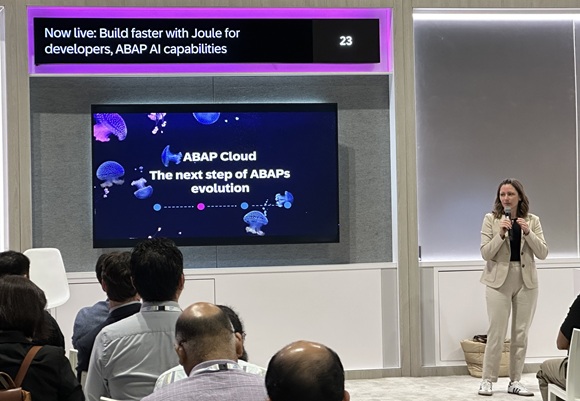SAP Sapphire 2025: Developers take centre stage as AI integration deepens
This is a guest post for the Computer Weekly Developer Network written by Amanda Razani, a technology journalist and podcast host with a strong background in technology media.
As the CWDN team was unable to attend SAP Sapphire in person this year, Razani has stepped in to provide some highly appreciated and insightful coverage of the event’s developer stream.
Razani writes in full as follows…
This week at SAP Sapphire 2025 in Orlando, SAP spotlighted a wave of developer-focused innovations aimed at making enterprise app development faster, smarter and more collaborative.
From AI-enhanced coding to a unified development environment, the announcements reflect SAP’s push to streamline how developers, from business technologists to backend ABAP engineers, build and extend business applications across the SAP ecosystem.
Tackling developer pain points
In a conversation on-site, Sid Misra, VP and head of product marketing for SAP Build, laid out the motivation behind these updates: Fragmentation, inefficiency and lack of integration across tools.
“Developers are often working with disconnected toolsets,” said Misra. “They’re starting from scratch or forced to piece together code, data and testing without much context. That’s a problem, especially when building mission-critical applications.”
SAP’s response to this is a single, unified solution within SAP Build on the Business Technology Platform (BTP), bringing together low-code, pro-code and AI-powered tools under one roof.
Developers working in Java, JavaScript or ABAP can now collaborate more effectively on the same application, effectively bridging silos that previously slowed enterprise innovation.
Joule for developers: a gen-AI boost
One of the standout updates is the Joule for Developers suite, a set of GenAI capabilities embedded into SAP Build and ABAP development environments. Using simple natural language prompts, developers can now:
- Generate front-end and back-end application components
- Automatically create unit tests and documentation
- Explain complex legacy ABAP code
- Accelerate app development with tailored recommendations
These features aim to reduce the time spent on repetitive coding and debugging tasks, freeing developers to focus on architecture and design.
“It’s not just about writing code faster. It’s about giving developers a smarter starting point,” said Misra.
In addition to creating applications, Devs can now build custom AI agents and skills via the new Joule Studio (launching soon). These agents will not only execute workflows but also adapt in real time, handling exceptions and adjusting processes quickly.
ABAP in the cloud: legacy to modern
Out on the show floor, Sonja Lienard, senior VP of development at SAP, offered a deeper look into how AI is transforming ABAP development, particularly in helping customers move from legacy ERP to SAP S/4HANA Cloud.
“Cloud is not a product. It’s a development model,” said Lienard. “We give ABAP developers stable APIs, a cloud-ready dialect and clear separation between SAP standard and customer extensions. That’s the foundation for a clean core strategy.”
Lienard demonstrated new features within the ABAP development Tools, including AI-powered code completion and test generation. These capabilities, underpinned by SAP’s domain-specific language models trained on millions of lines of ABAP, are now available and are intended to support both extension development and legacy code transformation.
Developers (and business) implications
SAP’s developer vision isn’t just technical; it’s strategic. With over 500 pre-built templates and a new Extension Wizard embedded directly into S/4HANA, developers no longer need to leave the SAP environment to start building or customising apps. From finance to recruiting workflows, teams can pull from finished app blueprints and tailor them to their enterprise data.
This move to context-aware, AI-supported development promises a faster path for businesses looking to modernise their operations without disrupting critical systems.
Importantly, Misra emphasised that SAP Build tools are not limited to SAP-only environments. “They expand out,” he said, highlighting compatibility with non-SAP systems and the ability to integrate with broader tech stacks via APIs and connectors.
Looking ahead
With SAP continuing to blur the line between applications and platforms, the company’s developer experience now hinges on flexibility and AI orchestration.

Razani on SAP: Eyeing a broader universe of software development toolsets, functions & platforms.
Whether through drag-and-drop low-code interfaces for business users or pro-code environments for engineers, the goal is clear: empower all types of developers to build faster, smarter and in tighter alignment with business goals.
Amanda Razani is known for leading insightful conversations across podcasts, webinars, roundtables and tech conferences. She is a moderator and speaker, regularly guiding discussions on AI, cybersecurity and digital transformation. Dedicated to continuous learning, Amanda stays current by attending major tech events throughout the year and earning certifications. She is also the co-founder and board member of the Concho Valley Technology Alliance and was named a Top 20 Under 40 Professional in 2018. Amanda holds a communications and journalism degree from Angelo State University.




